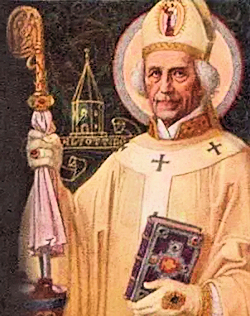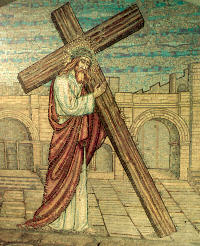Lent: March 27th
Monday of the Fifth Week of Lent
Other Commemorations: St. Rupert, Bishop (RM)
» Enjoy our Liturgical Seasons series of e-books!
Today we begin the fifth and final full week of Lent. In previous times the crosses and statues in church were veiled at this time to indicate Passion Time. Now the liturgical readings, day after day, tell of the lowering storm clouds that next week will break open. Today’s ancient Lenten readings taught the penitents (and teach us) that every sin is adultery to God—and is pardonable by Christ. —The Vatican II Weekday Missal
The Roman Martyrology today honors St. Rupert (d. 718), Bishop and missionary, also listed as Robert of Hrodbert. A member of a noble Frankish family, he was appointed bishop of Worms, Germany, and then dedicated himself to spreading the faith among the Germans. With the patronage of Duke Thedo of Bavaria, he took over the deserted town of Luvavum about 697, which was renamed Salzburg, Austria. Rupert founded a church, a monastery, and a school; brought in groups of missionaries; and established a nunnery at Nonnberg with his sister, Eerentrudis, serving as the first abbess. He died at Salzburg and is venerated as the first archbishop of this major diocese in the West. Rupert is revered as the Apostle of Bavaria and Austria.
Meditation
In early Christian biblical commentary, the innocent Susanna of today’s first Mass reading was presented as a type of the unjustly persecuted Church. Thus the assignment of the Susanna story to today’s liturgy is particularly appropriate given today’s statio at St. Chrysogonus, who, like Sebastian and George, was a soldier-martyr of the Diocletian persecution in the early fourth century. Veneration of St. Chrysogonus was so widespread in Rome that his name was inscribed in the Roman Canon (Eucharistic Prayer I). Chrysogonus conformed himself to the sacrifice of Christ on Calvary by offering his own life in witness to the grace of God that had transformed him. So did St. John Fisher, who provides the second selection in today’s Office of Readings. Fisher reminds Lenten pilgrims that the imitation of Christ, while perfected in martyrdom, also takes place in many other ways: “All who have embarked on true contrition and penance for the sins they have committed, and are firmly resolved not to commit sins again for the future but to persevere constantly in that pursuit of virtues which they have now begun, all these become sharers in [Christ’s] holy and eternal sacrifice.”
—George Weigel, Roman Pilgrimage: The Station Churches
St. Rupert of Salzburg
 St. Rupert was the first bishop of Salzburg, who, in some legends, is credited with giving the city its name.
St. Rupert was the first bishop of Salzburg, who, in some legends, is credited with giving the city its name.
Rupert was born in the late seventh century, to a part of the French imperial family. Little is known about his early life, but, like many sons of noblemen, entered the clergy. Rupert was elected bishop of Worms, a German city that was an important seat of power in the Carolingian dynasty.
At first, Rupert's flock welcomed his presence as a caring and faithful bishop. All too soon, however, the relationship between Rupert and the people of Worms soured. Conveniently, a Bavarian Duke, Theodo, asked for Rupert to come south to his palace at Regensburg to come spread Christianity to the diverse tribes he ruled over in Bavaria.
Rupert is often credited with baptizing Theodo, and officially welcoming him into the Church, as the seventeenth-century painting to the left depicts. And with Theodo's blessing, he began his missionary work among the Bavarian tribes.
Rupert found that Bavaria was still, in many ways, truly a wilderness with lots of outbreaks of violence. Thus, Rupert traveled to an old ruined Roman city and renamed it "Salzburg." Rupert founded and rebuilt several different monasteries in the area and lay the foundations of the Salzburg Cathedral. Where, a little over a thousand years later, Wolfgang Amadeus Mozart was baptized.
Rupert died in 710, and there's some dispute whether he had returned back to Worms at the time of his death or whether he died in Salzburg. His successor, Bishop Vergilius of Salzburg, interred his remains in the newly-finished Salzburg Cathedral in 774.
Rupert is known as the "Apostle to the Bavarians" and is a patron saint of Salzburg, Austria, and salt miners.
—Excerpted from Faith ND
Patronage: city of Salzburg, Austria; province of Salzburg, Austria; archdiocese of Salzburg; salt miners
Symbols and Representation: man holding a container of salt (refers to Salzburg and the salt mining there); wearing clerical clothes including mitre; holding a crosier
Highlights and Things to Do:
- Read more about St. Rupert:
- Read about St. Rupert's Fair, the biggest traditional fair in Europe.
- See the Stift St. Peter -- St. Peter's Abby that St. Rupert restored and lived.
- St. Rupert's remains are located at the Salzburg Cathedral at the Volksaltar.






